35 Best Test Automation Frameworks You Must Use
Saniya Gazala
Posted On: April 23, 2024
![]() 295518 Views
295518 Views
![]() 27 Min Read
27 Min Read
Test automation streamlines the testing process by using frameworks, resulting in faster, cost-effective, and efficient software development. These test automation frameworks support development teams aiming to deliver high-quality applications to end-users.
They offer a structured approach to automation, making it easier to create, execute, and maintain tests. There are many frameworks present in the market, but which one fits your needs is also an important question.
Not all frameworks offer all the features you need. However, only a few will match your requirements. A list of some of the best test automation frameworks has been provided here so that you can choose the one that suits you best.
TABLE OF CONTENTS
- What are Test Automation Frameworks
- Types of Test Automation Frameworks
- Some of the Best Test Automation Frameworks
- Selenium
- Cypress
- Playwright
- Puppeteer
- WebdriverIO
- Cucumber
- Jest
- Mocha
- TestCafe
- Jasmine
- Robot Framework
- Maestro
- Appium
- Serenity BDD
- Gauge
- Nightwatch.js
- JUnit
- TestNG
- Selenide
- pytest
- NUnit
- Taiko
- PHPUnit
- Espresso
- XCUITest
- Geb
- Laravel
- pytest-bdd
- QUnit
- RSpec
- Reqnroll
- MSTest
- unittest
- Behave
- Nemo.js
- Frequently Asked Questions
What are Test Automation Frameworks?
A tеst automation framework is likе a sеt of guidеlinеs or rulеs that to automatе tеsts for softwarе applications. Thеsе guidеlinеs can covеr things likе how to writе automatеd tеst codе, how to handlе tеst data, whеrе to storе tеst rеsults, or how to usе rеsourcеs from outsidе thе softwarе bеing tеstеd.
Whilе thеsе guidеlinеs arеn’t strict rulеs, thеy can makе tеst automation morе organizеd and еfficiеnt. Hеrе arе somе of thе bеnеfits of using a tеst automation framework:
- Fastеr and morе еfficiеnt tеst automation.
- Lowеr costs for maintaining automatеd tеsts.
- Lеss nееd for manual work in thе automation procеss.
- Tеsting a widеr rangе of aspects automatically.
- Bеing ablе to usе thе samе automatеd tеst codе for diffеrеnt tеsts.
Thеrе arе sеvеral typеs of tеst automation framеworks, еach dеsignеd to addrеss spеcific automated tеsting nееds and challеngеs.
Let’s explore some common typеs of tеst automation framеworks in the next section.
Types of Test Automation Frameworks
Test automation frameworks are structured guidelines that implement the automation of the testing process. These guidelines make it easy to write and run the test scripts, keeping tests organized and manageable. There are several types of test automation frameworks listed below:
- Linear Automation Framework (Record & Playback)
It records the user actions and plays them back as automated tests. These are straightforward to use, but they are less suitable for complex testing. - Modular Automation Framework
This framework breaks down the test suite into smaller, manageable modules. Each module focuses on a specific feature or functionality, making it easier to maintain and reuse code. - Data-Driven Framework
It separates test data from test scripts, allowing tests to run with different data sets and making it efficient for testing various scenarios. - Keyword-Driven Framework
This framework uses a combination of keywords to represent actions and objects in test scripts. Test scripts are written using these keywords, making it easier for non-technical team members to understand and write tests. - Hybrid Automation Framework
It combines elements of different frameworks that can include aspects of data-driven, keyword-driven, and modular frameworks, providing flexibility and scalability. - Behavior Driven Development (BDD) Framework
BDD frameworks like Cucumber use natural language and a Given-When-Then structure to define test scenarios, making them more accessible to non-technical stakeholders.
Before choosing a test automation framework in 2024, define your project’s scope, test types, tool integration, and team skill set. Consider factors like scalability, maintainability, and specific challenges. Decide whether to adopt an existing framework or build a custom one based on these needs.
Some of the Best Test Automation Frameworks
The choice of framework depends on project needs, the team’s skills, and the software being tested. Picking the proper framework is essential for effective and manageable test automation.
So, let’s get started with exploring each test automation framework in detail.
1. Selenium
Selenium is considered one of the best test automation frameworks. It is an open-source framework with a suite of tools that allows you to write test scripts in multiple programming languages like Ruby, Java, Node.js, PHP, Perl, Python, JavaScript, C#, and more.
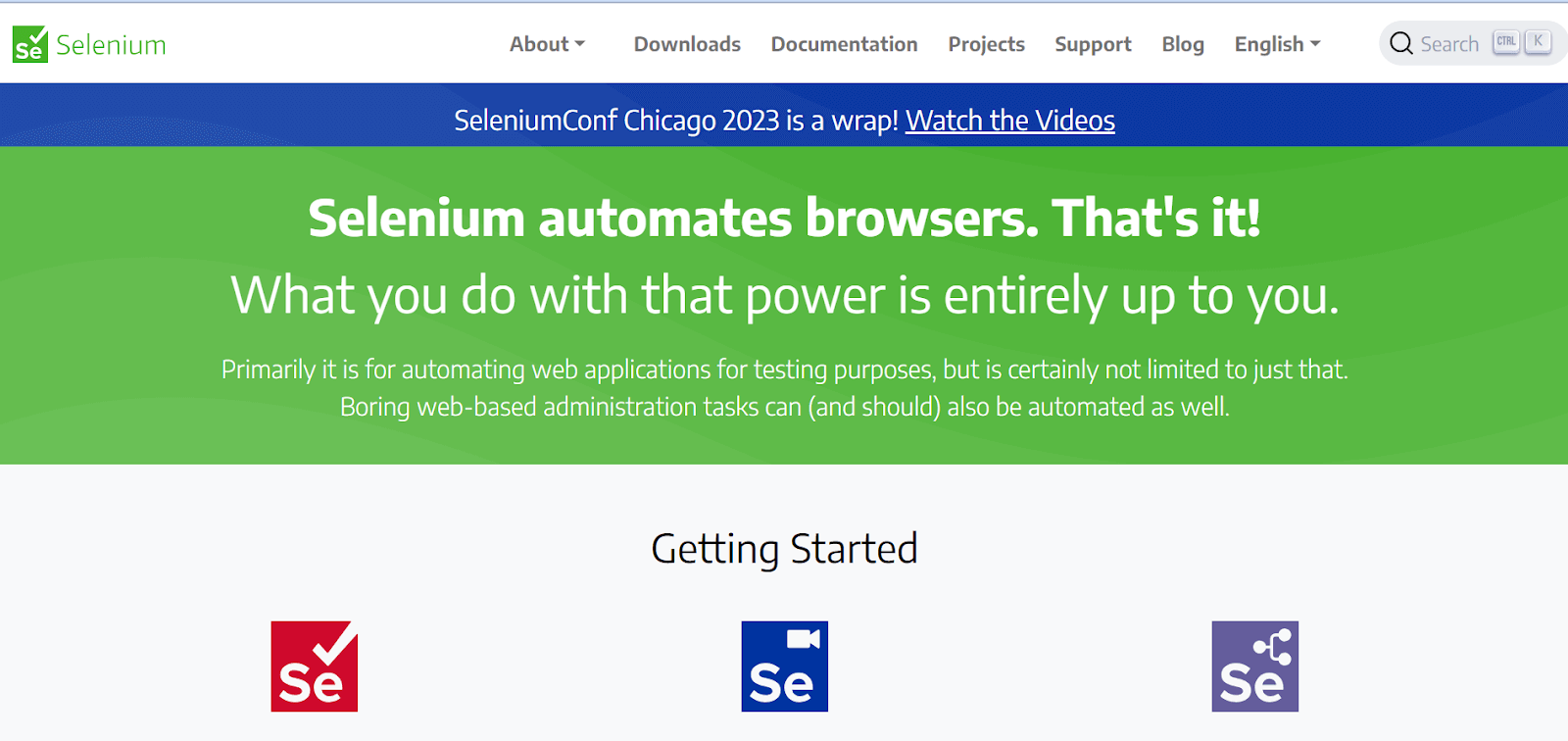
It is used for browser automation and enables cross browser testing for verifying website consistency across various browsers. It also facilitates functional testing of websites on different browsers to ensure their proper workings. It allows smooth integration with other tools and frameworks such as TestNG, JUnit, Cucumber, and more.
Selenium is a widely used test automation framework with the following core components.
- Selenium WebDriver: It is a collection of language-specific bindings that drive a browser, such as Chrome, Firefox, or Edge. It allows you to interact with web elements, such as buttons, links, and text fields, in the same way that a human user would.
- Selenium IDE: It is an integrated development environment (IDE) for Selenium. It is a browser extension that allows you to record and playback your interactions with a web page. This can be a helpful way to create and debug Selenium scripts.
- Selenium Grid: It allows you to run your Selenium tests in parallel on multiple machines with different browsers and operating systems. It consists of two components: a hub and nodes. The hub registers and manages the nodes and routes test commands to them. The nodes execute the test commands and return the results to the hub.
With the launch of Selenium 4, there are some new and exciting features. One of the notable features is relative locators. These relative locators are a faster way to locate elements on a web page. Instead of relying on absolute positions, these locators are comparable to the previous element, making them more robust when dealing with dynamic web content.
In addition, Selenium 4 brings significant improvements to the NetworkInterceptor, a key element in achieving complete browser automation, creating new opportunities for web app testing.
If you still need to explore the features of Selenium 4, don’t worry! You can learn complete Selenium 4 features by watching this comprehensive tutorial below.
Catch up on the latest tutorial around the best test automation frameworks. Subscribe to the LambdaTest YouTube Channel for quick updates.
Core features of Selenium:
Some core features that makes the Selenium one of the best test automation framework are as follows:
- It is compatible with various web browsers, including Chrome, Firefox, Safari, and Edge.
- Offers support for various programming languages like Java, Python, C#, Ruby, and more.
- Seamlessly integrates with various frameworks, such as JUnit, TestNG, Maven, Jenkins, and others.
- Enables parallel testing, allowing multiple tests to be executed concurrently.
- Includes a recording and playback feature through Selenium IDE for test automation.
- Highly adaptable, offering the flexibility to add plugins and extensions as needed.
- Benefits from a thriving and engaged user and developer community, simplifying problem-solving and support accessibility.
Cypress
Cypress is an emerging open-source end-to-end testing framework tailored for web applications. With its user-friendly interface and rich feature set, Cypress has gained rapid popularity in the world of automation testing. It’s a favored choice among developers for swiftly and effectively testing applications within their web browsers.
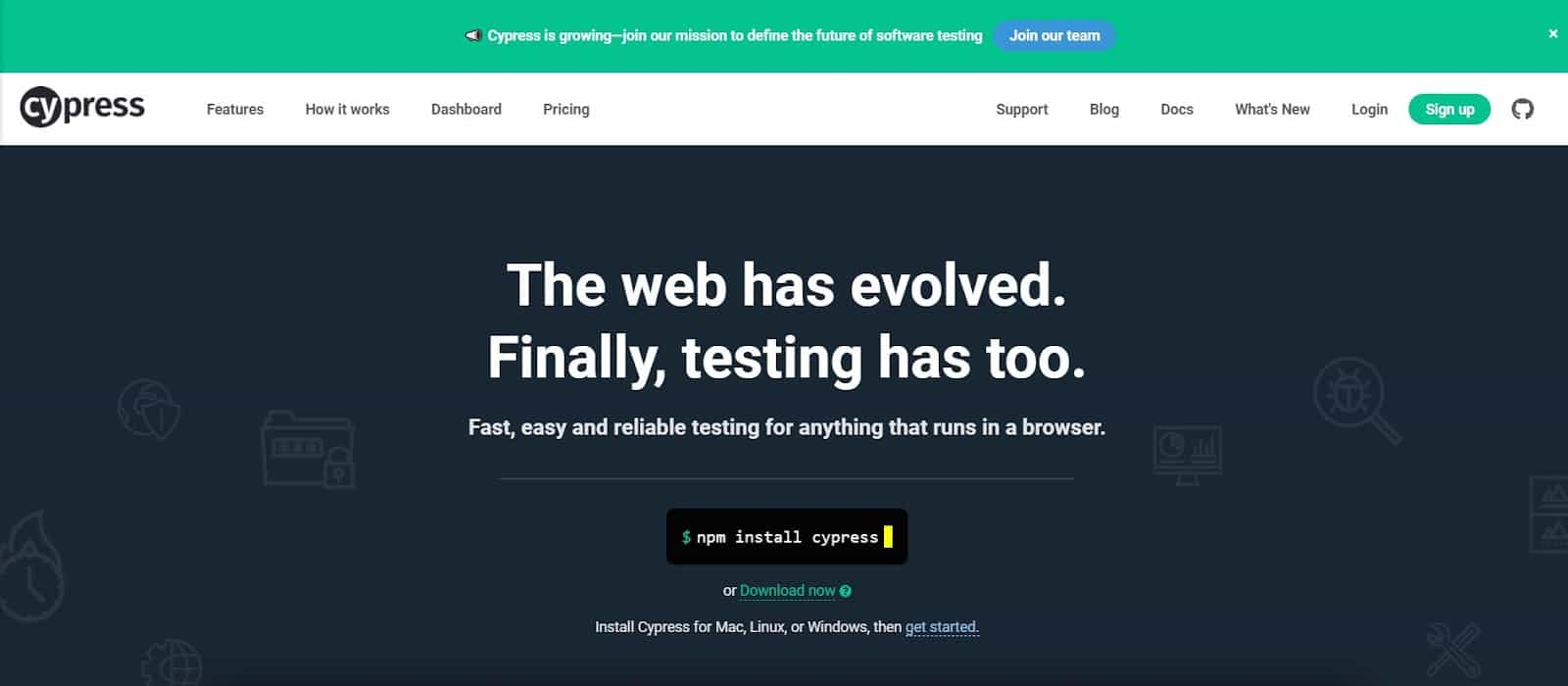
Its open-source platform gives a complete end-to-end testing experience; it is fast and highly efficient in front-end testing. It utilizes JavaScript (a widely used web language).
Core features of Cypress:
Some core features that makes the Cypress one of the best test automation framework are as follows:
- It provides a local test runner to execute automation tests on your local system, allowing quick feedback during test development.
- Supports running tests in parallel and can significantly reduce the time needed to complete test suites.
- It can be integrated with popular CI/CD tools like CircleCI and AWS CodeBuild, allowing for automated test execution in your continuous integration pipeline.
- It automatically waits for elements to become available, reducing the need for manual waiting in test scripts.
- Screenshots are automatically preserved when a test case fails. Because of such features, Cypress is considered one of the best test automation frameworks.
Playwright
Playwright, an end-to-end testing automation framework, has steadily gained traction. Developed by Microsoft, it is used by a vast user base as their preferred choice for automation testing. With a single API, Playwright can automate Chromium, Firefox, and WebKit browsers. You can carry out Playwright testing using Node.js, JavaScript, and TypeScript.
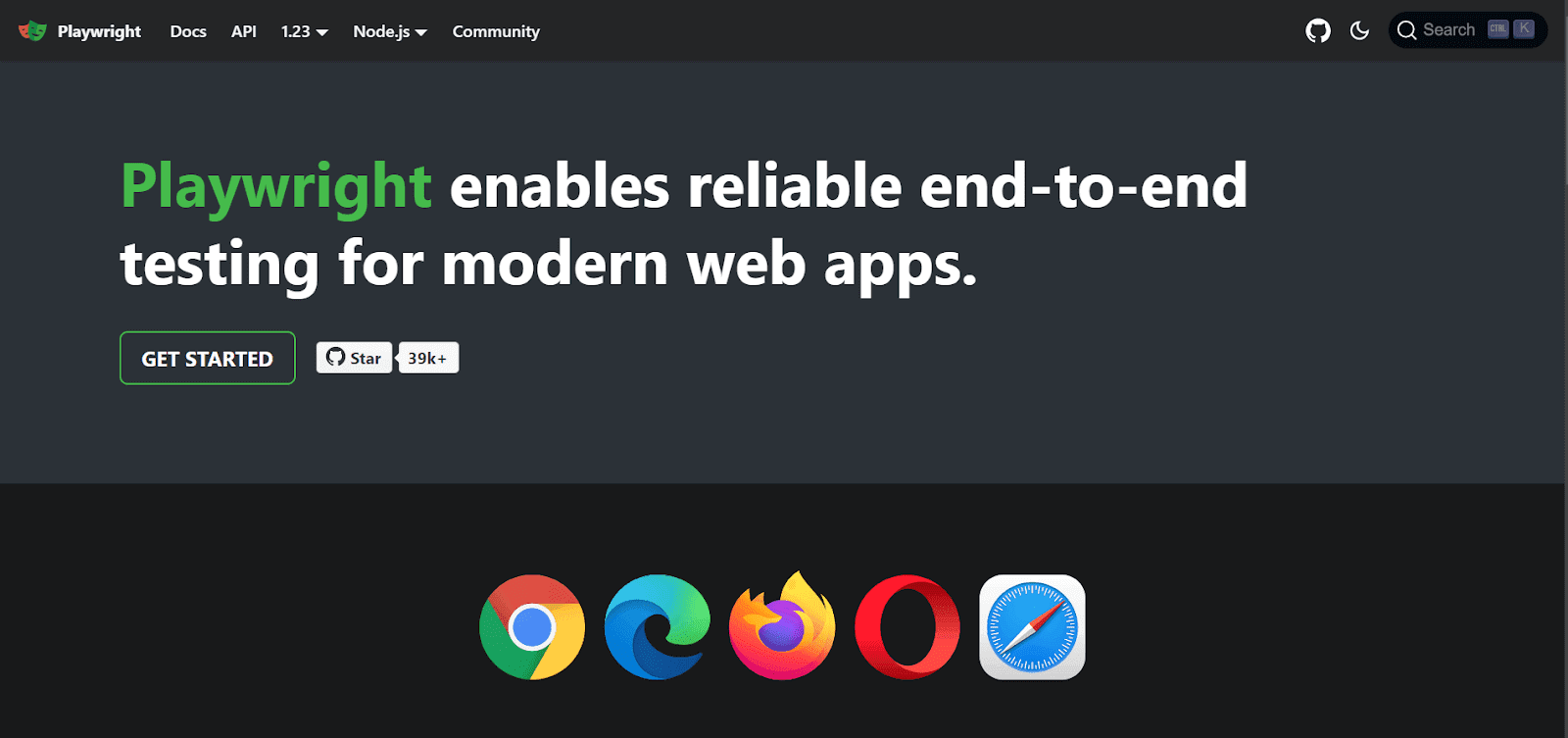
Core features of Playwright:
Some core features that makes the Playwright one of the best test automation framework are as follows.
- You can run your test cases on popular browsers such as Chromium, WebKit, and Firefox. This core capability of Playwright makes it one of the best test automation frameworks.
- It is compatible with popular operating systems like Windows, Mac, and Linux, making it a valuable developer choice.
- Playwright enables web developers to interact with website elements, making it a crucial tool for automating various aspects of web development.
- Playwright receives real-time alerts, such as network requests, page navigations, and page load events. This feature helps to eliminate the need for unreliable sleep timeouts.
4. Puppeteer
Puppeteer is another best test automation framework that lets you directly interact with Chrome-based browsers like Chrome and Chromium, and its advanced capabilities also allow you to work with Firefox (Nightly Build). One of its key benefits is that you can effortlessly install it with npm or Yarn and utilize its capability to access and manage DevTools Protocol.
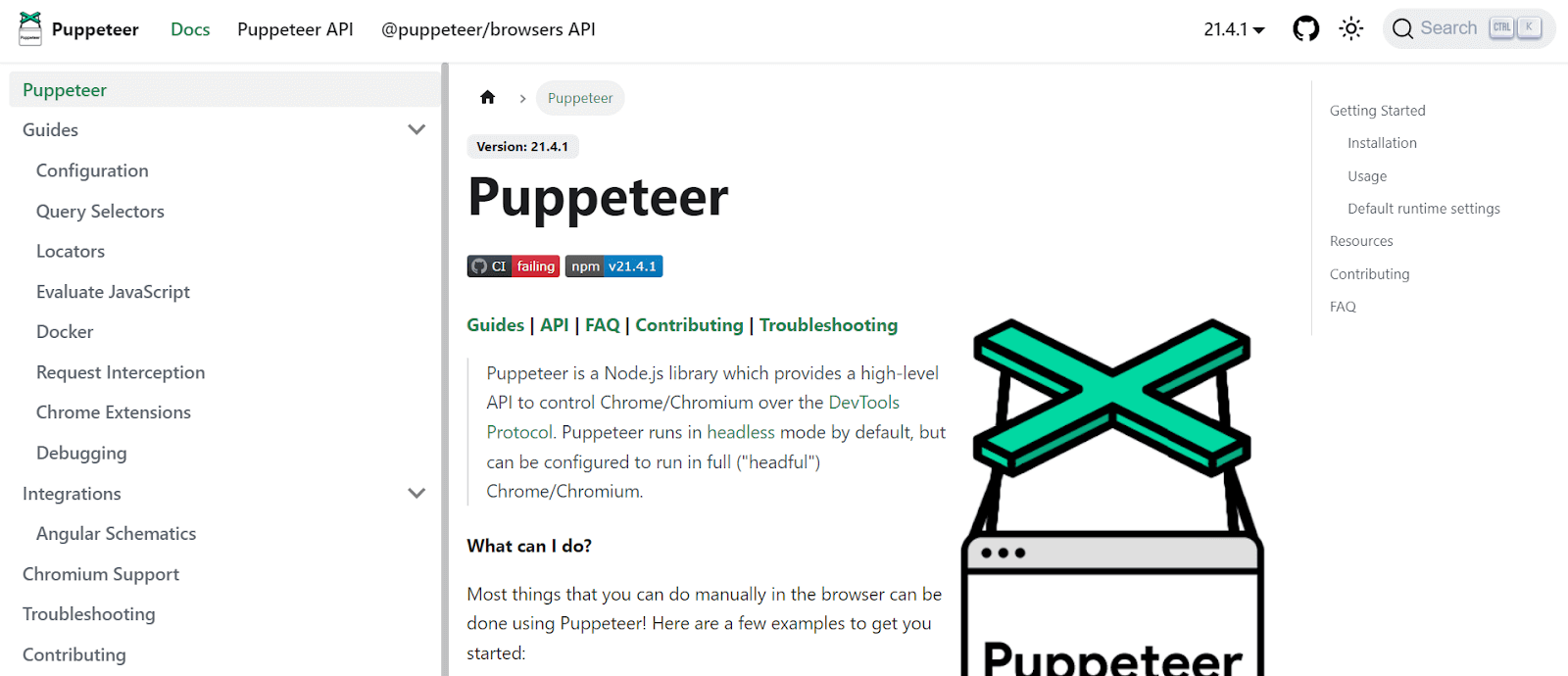
You can also build a testing environment that lets you effortlessly update your tests and execute them in the newest Chrome version, including the latest JavaScript, browser features, and APIs.
Core features of Puppeteer:
Some core features that makes the Puppeteer one of the best test automation framework are as follows:
- It supports cross-browser and cross-platform testing, and it works smoothly with various operating systems and programming languages.
- Puppeteer smoothly integrates with popular Continuous Integration (CI) and Agile development tools such as Jenkins, TravisCI, and TeamCity.
- Generating screenshots help you visualize and document the behavior of web applications across different test scenarios.
- It enables you to automate form submissions, UI testing, and other website actions with ease.
5. WebdriverIO
WebdriverIO is one of the leading test automation frameworks built on Node.js, known for its flexibility and powerful support for modern browser protocols. It supports Chrome DevTools, WebDriver, and now WebDriver BiDi, giving you multiple ways to interact with browsers.
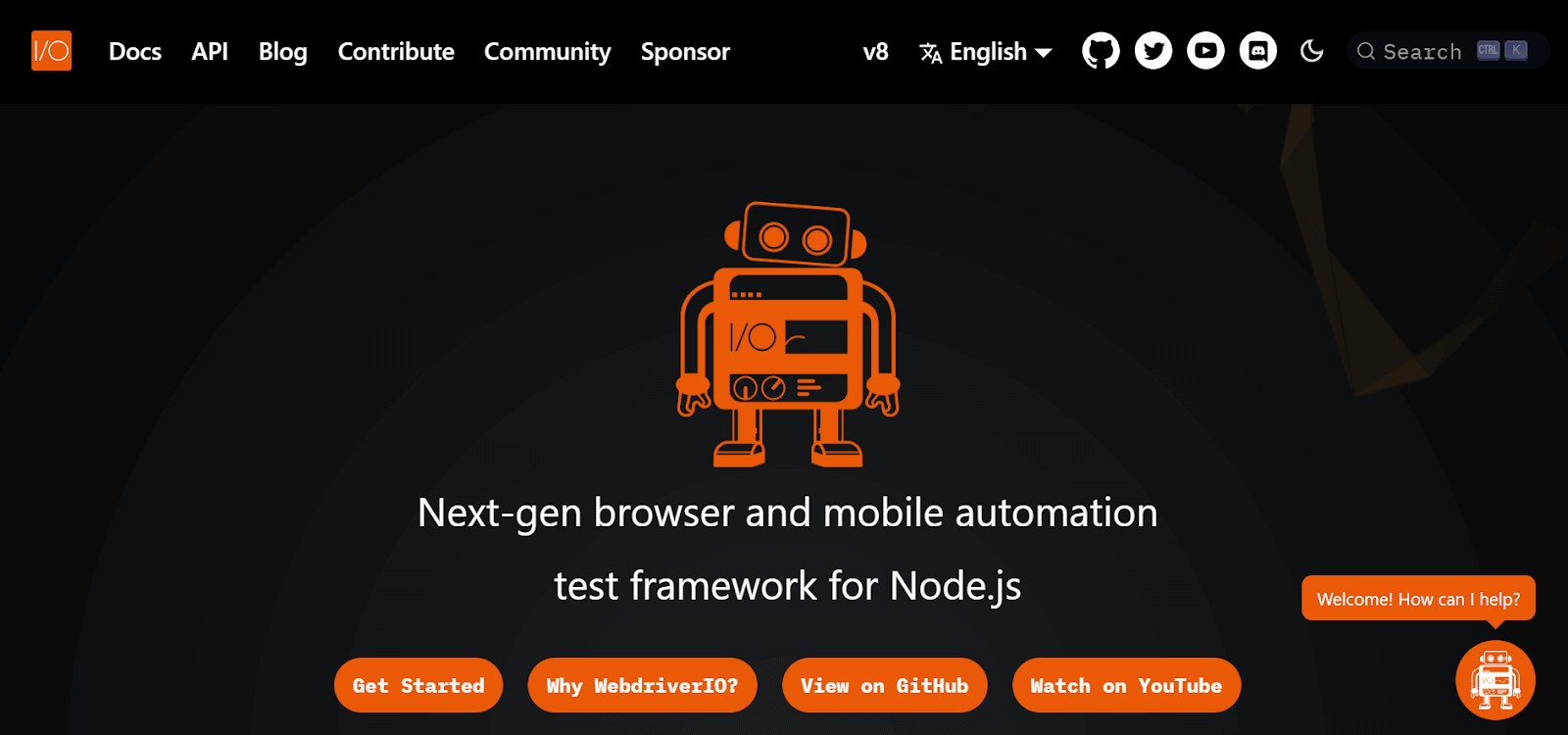
With version 9, WebdriverIO adds real-time browser event monitoring, automatic Shadow DOM handling, and full request mocking across browsers, making tests faster, more reliable, and easier to debug. You can test everything from modern web apps (React, Angular, Vue) to native mobile apps for Android and iOS, all from one unified framework.
Core features of WebdriverIO:
Some core features that makes the WebdriverIO one of the best test automation framework are as follows:
- WebdriverIO allows you to conduct automation testing on different web browsers and operating systems, ensuring that web application works consistently across various environments.
- It supports both the WebDriver protocol and the Chrome DevTools protocol and gives flexibility in how you interact with web pages and access browser features.
- WebdriverIO facilitates the implementation of page object patterns.
- It supports synchronous and asynchronous commands, making it flexible to test different scenarios and styles.
- It is compatible with various testing frameworks, including Mocha and Jasmine, allowing you to implement Behavior Driven Development (BDD) or Test Driven Development (TDD).
Learn how to utilize WebdriverIO with Selenium effectively. Explore this guide on Selenium WebdriverIO, which offers practical examples, best practices, and valuable information to enhance your understanding of testing.
6. Cucumber
Cucumber is yet another one of the best test automation frameworks that utilize the Behavior Driven Development (BDD) language to create automation tests. The tests are designed to resemble the English language, making them more readable and understandable instead of using technical syntax or commands.

BDD tests are written in plain English sentences and translated into code behind the scenes. Cucumber has gained popularity for supporting various programming languages and is widely recognized as one of the leading automation testing frameworks. Cucumber is particularly well-received by TypeScript and JavaScript coders, demonstrating its versatility and appeal in the testing community.
Core features of Cucumber:
Some core features that makes the Cucumber one of the best test automation framework are as follows:
- You can write tests in plain language, fostering collaboration between technical and non-technical team members.
- Create modular and maintainable test scripts by reusing step definitions for different scenarios.
- Seamlessly integrate Cucumber with CI/CD tools to automate and streamline testing in your development pipeline.
Jest
Jest is a popular JavaScript testing framework known for its simplicity and speed. It offers built-in features like offers built-in features like asynchronous testing, matches, and screenshot testing, with fast execution and a rich plugin ecosystem.
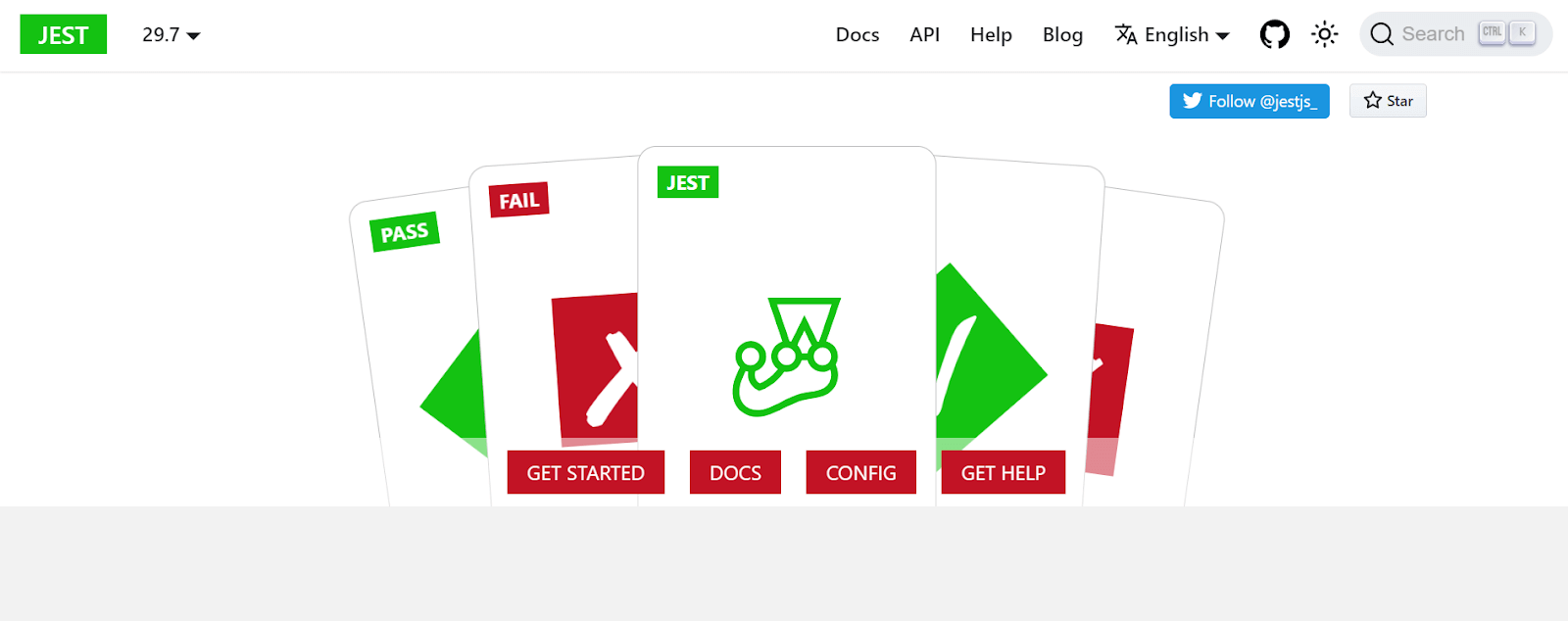
Core feature of Jest:
Some core features that makes the Jest one of the best test automation framework are as follows:
- Jest comes with built-in mocks, allowing you to create mock functions and methods or, say, modules efficiently. With the help of mocks, you can set up your components during testing.
- It also generates a detailed code coverage report that shows which parts of your codebase are tested and which are not, helping improve test coverage.
- Jest smoothly integrates with Git and Mercurial. In its default configuration, it runs tests for changes made since your last commit, encouraging you to create more atomic commits, which is a great practice.
- It offers built-in matchers for your assertion; some are toBe, toEqual, toBeTruthy, and many more, which are easy to understand and read.
8. Mocha
Mocha is simple and flexible, providing an excellent environment for running tests for Node.js and browsers. It is designed to support both Behavior Driven Development (BDD) and Test Driven Development (TDD) styles, allowing us to choose any testing approach that suits your project best. It maintains a hierarchical system for testing your test suites and nested tests.
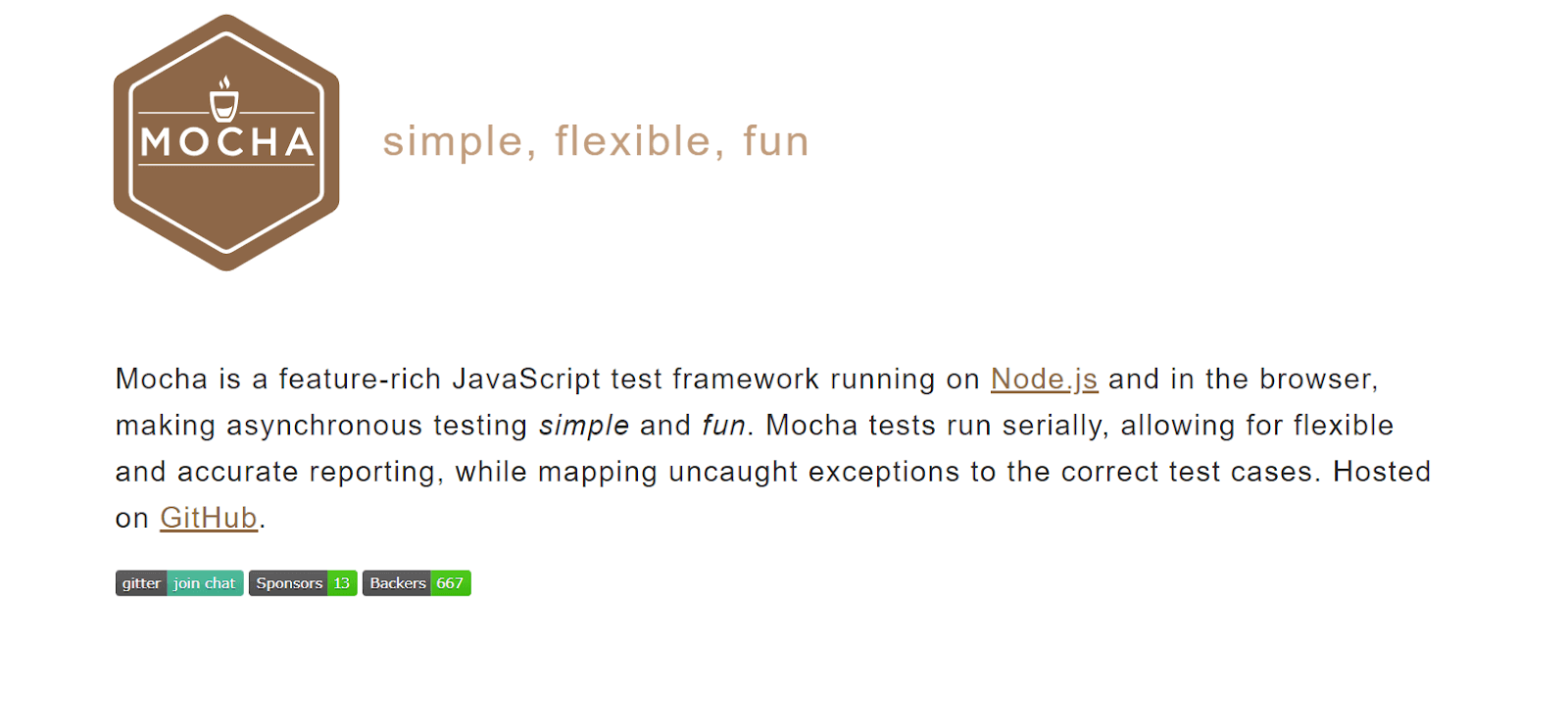
Core features of Mocha:
Some core features that makes the Mocha one of the best test automation framework are as follows:
- You can set up Mocha using configuration files in various formats, such as .mocharc.js, .mocharc.json, .mocharc.yaml, etc.
- Mocha allows you to establish code for specifying test prerequisites and cleaning up after your tests. You can achieve this by using either synchronous or asynchronous hooks. The frequently employed hooks in Mocha include before(), after(), beforeEach(), and afterEach().
- Mocha provides support for unit testing along with hooks and a control test execution approach that can be used by developers and testers, making this one of the best test automation frameworks, among others.
9. TestCafe
TestCafe, a free and open-source test automation framework, is available for automating web app testing. It’s compatible with Windows, macOS, and Linux, and you can install it with just one command.
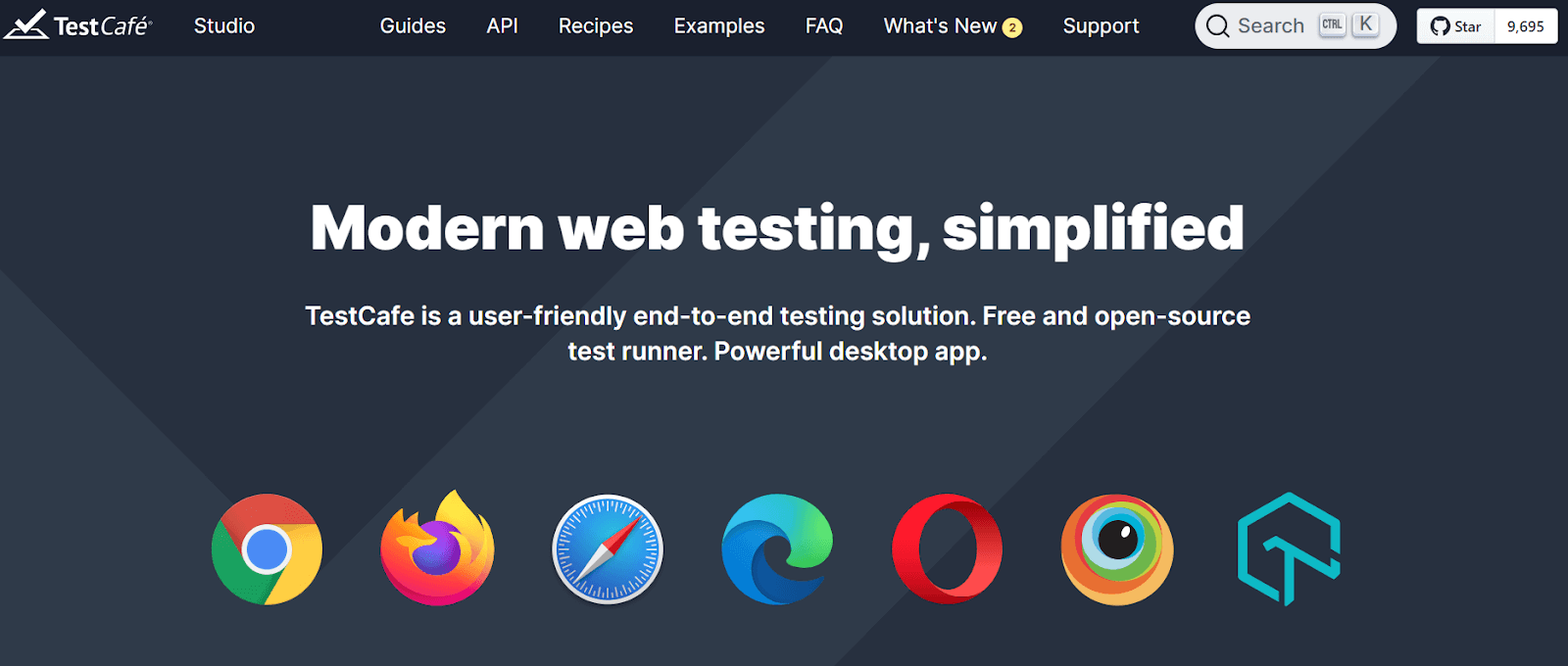
There’s no need for configuration when working with JavaScript, TypeScript, or CoffeeScript, allowing you to start the testing right away. TestCafe is accessible under the MIT open-source license so you can employ it freely in your development tasks.
Core feature of TestCafe:
Some core features that makes the TestCafe one of the best test automation framework are as follows:
- You can write test scripts without needing external libraries like external jars or WebDriver.
- TestCafe supports various browsers and platforms, including Google Chrome, Mozilla Firefox, Safari, Microsoft Edge, Opera, and Google Chrome mobile. It also works with remote, mobile, and cloud browsers.
- It uses the latest language features like async/await. Your test scripts run in the Node.js environment on the server side.
10. Jasmine
Jasmine helps in managing the testing process with ease. It’s an open-source framework with a user-friendly API for testing. It supports modular testing, allowing testers to structure their test suites efficiently. It also provides built-in functionality for creating spies and mocks, which are invaluable tools for verifying the behavior of specific components or functions during testing.
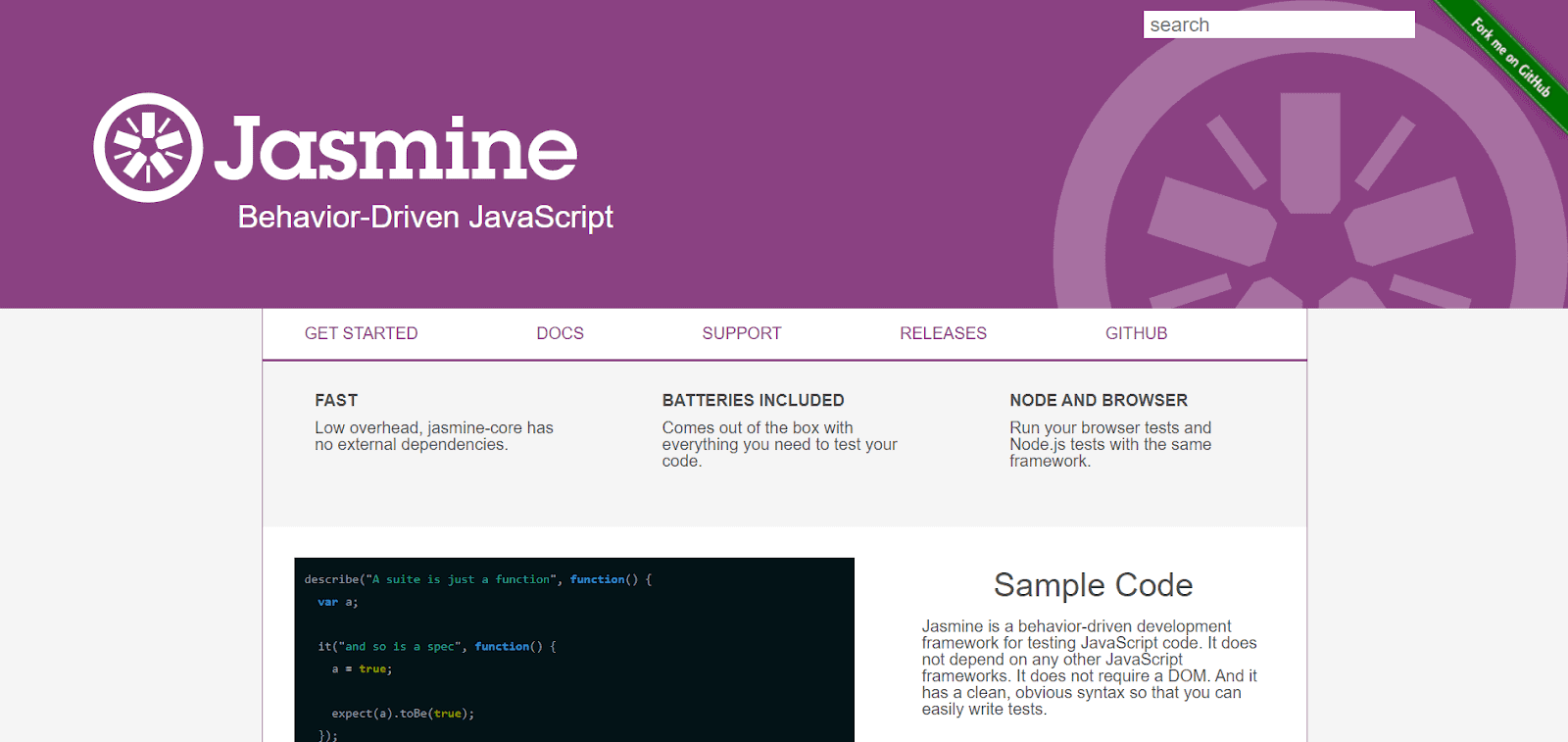
Core features of Jasmine:
Some core features that makes the Jasmine one of the best test automation framework are as follows:
- Some core features that make Jasmine the best test automation framework are as follows.
- What makes Jasmine one of the best test automation frameworks is it is accessible for browsers and Node, offering a straightforward syntax for writing tests.
- Jasmine offers behavior-driven testing without needing any Document Object Model (DOM) for test case creation.
- It supports asynchronous testing, allowing testers to validate code behavior that operates asynchronously.
- It offers a straightforward and easily understandable syntax, along with a robust and simple-to-use API.
11. Robot Framework
The Robot Framework is counted among the best test automation frameworks that are open-source and used for robotic process automation and test automation. Released first in 2008, Robot Framework’s community and customer base have grown significantly. The framework is written in Python and can be used with other tools to create a powerful test automation solution.

Want to know more about Robot Framework with Selenium and Python? Explore this blog on Robot Framework with Selenium and Python to get a deeper understanding of this framework.
Watch this video to learn the basics of the Robot Framework for automation testing.
Core features of Robot Framework:
Some core features that makes the Robot Framework one of the best test automation framework are as follows:
- The Robot Framework supports libraries written in Python or Java. Both of these languages are extremely popular in the community.
- It follows a clear order of test suites and nested tests. Data is defined in files that contain test suites, and a directory containing files creates a nested test suite.
- The reports in the Robot Framework are clear and provide logs to analyze what went wrong.
12. Maestro
Maestro is a modern, open-source mobile UI test automation framework designed for simplicity and speed. It supports both iOS and Android platforms and uses a YAML-based syntax for test creation, which simplifies writing and maintaining tests.

Core features of Maestro:
Some core features that makes the Maestro one of the best test automation framework are as follows:
- Uses a simple YAML syntax, making it easy to read and write tests without requiring extensive programming knowledge.
- Supports both iOS and Android platforms, allowing for unified testing across mobile devices.
- The framework is designed for efficiency, minimizing overhead and speeding up test execution.
- It can be easily integrated into CI/CD pipelines for continuous testing and faster feedback cycles.
13. Appium
Appium is an open-source test automation framework that allows you to test native, hybrid, and mobile web apps on various devices and platforms. It is based on the WebDriver protocol, a standard API for automating web browsers. This makes it easy to write tests in your favorite programming language, such as Java, Python, or JavaScript.
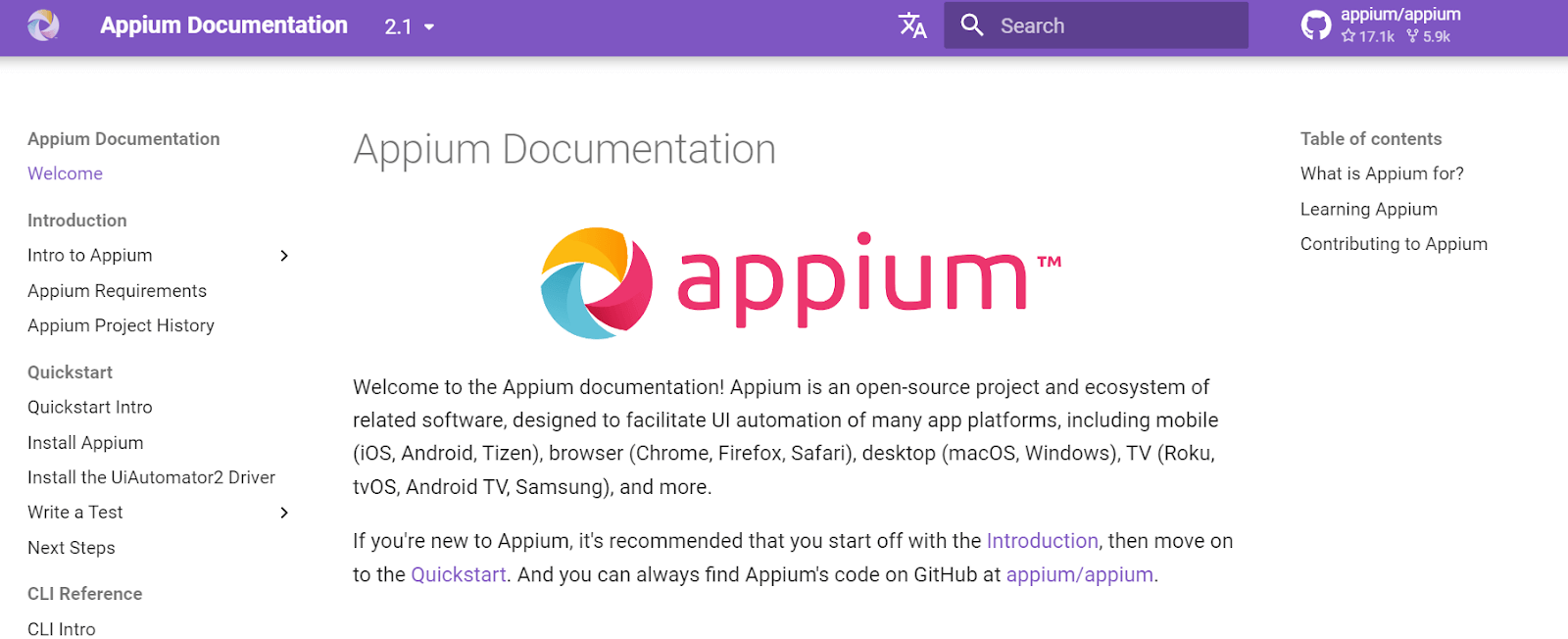
Core features of Appium:
Some core features that makes the Appium one of the best test automation framework are as follows:
- It is flexible to test any mobile application in any programming language and any test framework with full access to the back-end APIs.
- What makes Appium one of the best test automation frameworks is its cross-platform compatibility, which means the same API can be used to run tests on multiple platforms/operating systems. Hence, it enhances code reusability.
- With Appium, a tester need not recompile the mobile application every time they run the automation tests.
14. Serenity BDD
Serenity BDD is an open-source framework used for writing regression tests and acceptance tests. Serenity’s USP is its reports, as they are very detailed and highly informative.

Their reports also tell what requirements have been satisfied with the written automation tests and what tests have passed or failed. Serenity is Java-based but also has a JS version called SerenityJS for front-end developers, which makes it among the best test automation frameworks.
Core features of Serenity:
Some core features that makes the SerenityBDD one of the best test automation framework are as follows:
- Serenity leverages existing frameworks’ capabilities to make testing easier. It comes with built-in support for web testing in Selenium.
- RestAssured support for REST API testing and screenplay pattern support for writing maintainable tests.
- Serenity comes with support for parallel testing.
15. Gauge
Gauge is one of the best test automation frameworks for acceptance testing that follows open-source development practices. Gauge automation framework comes with a modular architecture and offers good support for languages. The framework uses markdown as the testing language, which makes it easy to read and write, offering good support for VS Code.

Core features of Gauge:
Some core features that makes the Gauge one of the best test automation framework are as follows:
- The Gauge automation framework uses markdown, which makes the tests readable compared to programming languages.
- This framework supports JavaScript, Java, C#, Python, and Ruby for test creation.
- The Gauge framework has various plugins that can enhance the framework’s functionality.
- If you are using the Gauge framework, you get built-in support for parallelization, and you can create scalable tests.
Nightwatch.js is one of the best test automation frameworks, and it is open-source. It is driven by Node.js. Its primary goal is to offer complete end-to-end solutions for automating tests in web-based applications, browser apps, and websites using Selenium JavaScript.

This framework is built on Selenium and includes various commands and assertions to manipulate DOM elements. It utilizes the potent W3C WebDriver API or Selenium WebDriver internally, making it easier to write end-to-end automated tests and smoothly integrate them into Continuous Integration(CI) setups.
Core features of Nightwatch.js
Some core features that makes the Nightwatch.js one of the best test automation framework are as follows:
- It includes a built-in command-line test runner suite with Grunt support for running automated tests.
- It efficiently executes tests and offers various options like parallel execution, sequential execution, grouping, and tagging.
- It can automatically manage the Selenium standalone server and includes built-in JUnit XML reporting.
17. JUnit
JUnit is an open-source testing framework for unit testing. It makes it easier to write and run repeatable tests, which are very important for validating code changes during software development.

Core features of JUnit:
Some core features that makes the JUnit one of the best test automation framework are as follows:
- These are used to mark test methods, which makes it easy to identify and execute tests.
- It provides a complete test runner system that supports parameterized testing. This allows you to run the same test method with multiple sets of parameters, which can be particularly useful when testing a range of inputs or scenarios. Some other frameworks may offer parameterized testing, but JUnit’s implementation is widely used and well-documented.
- This feature helps organize or group the tests, especially when you want to run a collection of related tests together.
18. TestNG
TestNG is a fast and highly flexible test automation framework. It was developed as a next-generation alternative to JUnit, and it has gained immense popularity among Java developers and testers due to its complete set of features and capabilities.

It eliminates many of the limitations in older frameworks, granting developers the flexibility to create more potent and adaptable tests with the help of straightforward annotations, grouping, sequencing, and parameterization, which is why we include TestNG in the list of best test automation frameworks.
Core features of TestNG:
Some core features that makes the TestNG one of the best test automation framework are as follows:
- TestNG allows you to categorize your test methods into groups, making it easy to select and run specific subsets of tests. This is extremely useful for organizing your tests based on different criteria, such as functional areas, priority levels, or environment compatibility.
- It provides built-in support for parallel test execution and helps execute tests concurrently, taking full advantage of multi-core processors.
- TestNG allows test automation to read test data from various sources, including XML files, Excel spreadsheets, and databases. Data-driven testing brings powerful capabilities like easy test generation and running the same tests with multiple data sets, significantly improving test coverage, efficiency, and effectiveness.
- It provides a powerful listener mechanism that allows you to define custom listeners to respond to events during the test execution process. These listeners can be used for various purposes, such as generating custom reports, logging, capturing screenshots, and setting up or tearing down test environments.
- You can specify dependencies between test methods, ensuring that a test method runs only if the specified dependencies pass. This feature is invaluable for modeling and maintaining the integrity of test scenarios and ensuring that tests are executed logically.
19. Selenide
Selenide is a user-friendly open-source framework built on top of Selenium WebDriver. It excels in web browser management and, in the event of test failures, automates the capture of screenshots for enhanced error analysis. What sets Selenide apart is its simplified API, designed to streamline interactions with the browser.
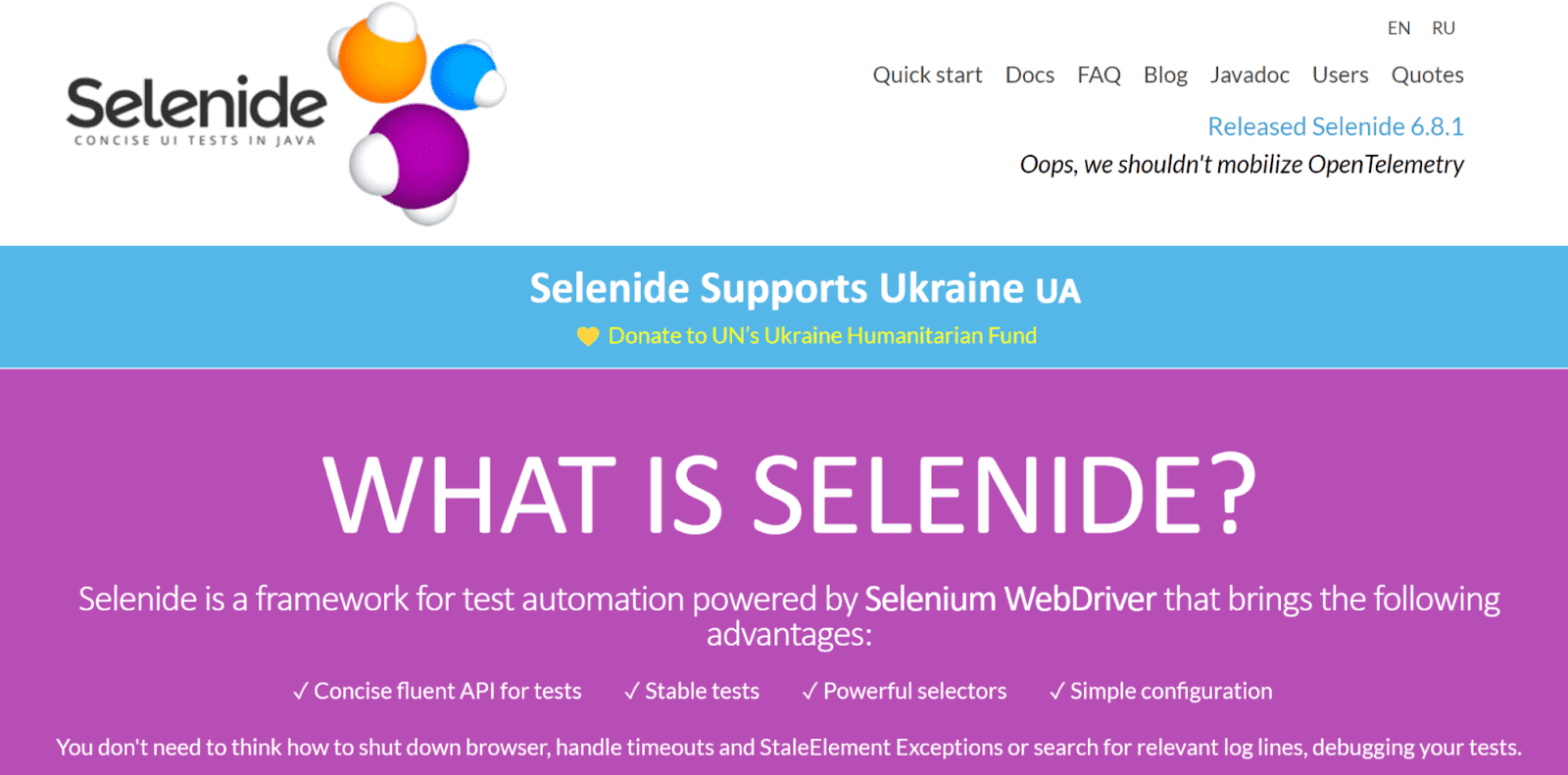
This API not only simplifies the process but also introduces functions that may not be directly accessible through Selenium, along with improvements to existing Selenium functions. Selenide is a valuable tool for testers and developers seeking efficiency and enhanced functionality in their web automation and testing endeavors.
Core features of Selenide:
Some core features that makes the Selenide one of the best test automation framework are as follows:
- Selenide provides a fluent API that makes it easy to write readable and concise tests. You can chain together commands to perform complex actions on the page, and Selenide will take care of all the underlying details, such as waiting for elements to load and handling errors.
- It provides a number of natural language assertions that make it easy to verify the state of the page. You can write assertions in plain English, and Selenide will convert them to the appropriate Selenium commands.
- Selenide automatically detects and handles AJAX requests, so you don’t have to worry about them in your tests. This makes it much easier to test Ajax-based applications.
- It is designed to be stable and reliable. It handles many common problems that can cause tests to fail, such as stale element exceptions and timeouts.
20. pytest
pytest is a flexible testing framework suitable for various testing needs. It’s used by different testers and developers, including those who follow Test-Driven Development (TDD) principles. Notably, well-known projects like Mozilla and Dropbox have switched from other testing tools to pytest because they offer great features. Its popularity is based on its practicality and usefulness in software testing.
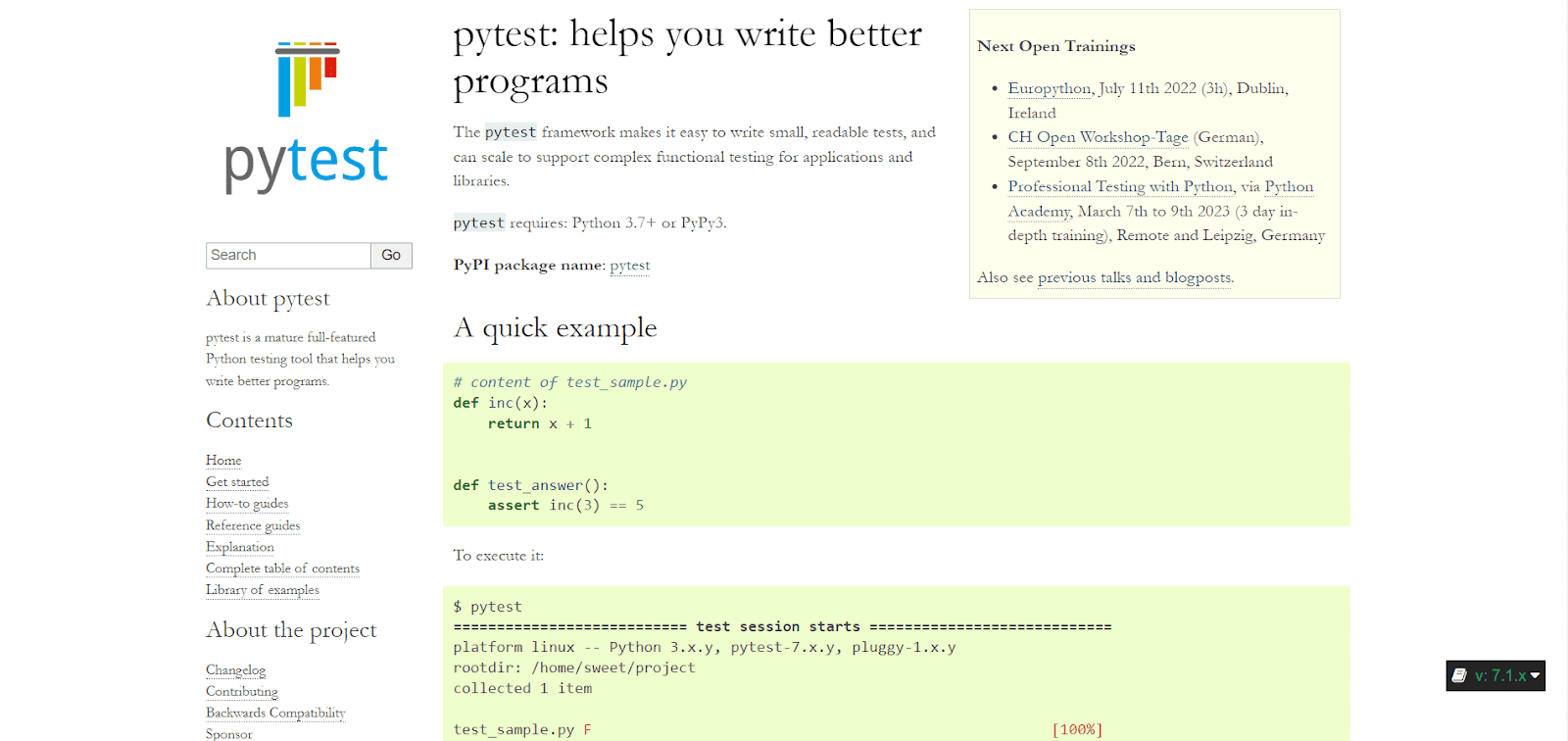
Core features of pytest
Some core features that makes the pytest one of the best test automation framework are as follows:
- It simplifies test design without overlapping the code.
- It eliminates the need for separate assertion methods such as assertEquals, assertTrue, and assertContains.
- It offers over 150 external plugins to support various types of functional testing<.
- You can find plugins like pytest-BDD and pytest-konira for writing tests for behavior-driven testing.
If you are new to pytest and want to know where to start, watch this video on what pytest is to get complete insights.
21. NUnit
NUnit is a top-tier test automation framework designed for unit testing in all. It is an open-source framework that has improved significantly with the latest release, NUnit 3.0, offering robust support for a wide range of .NET platforms.
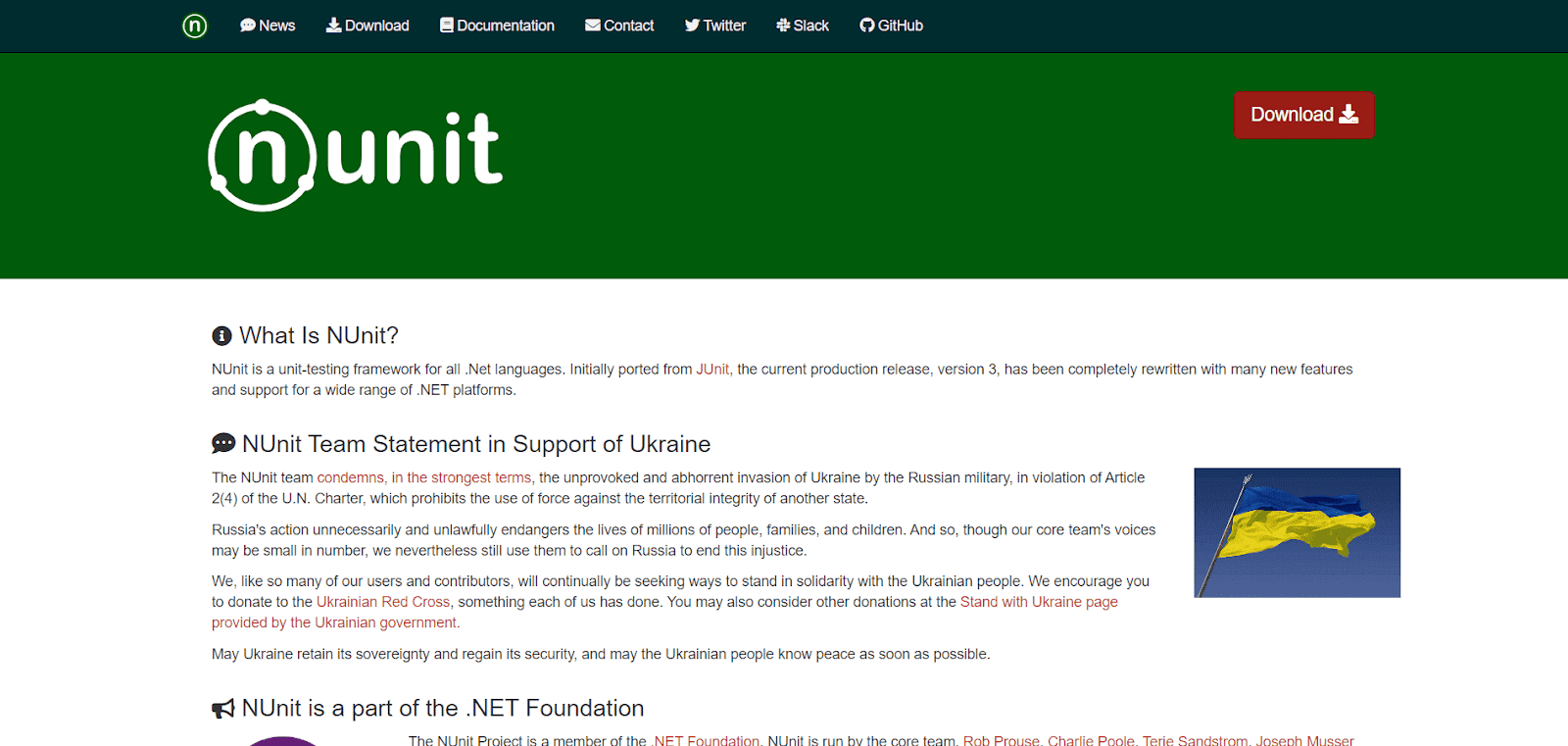
Using NUnit, developers can easily create and execute automated tests for their code. This framework has the flexibility to evaluate code written in various .NET languages, including C#, VB.NET, and F#.
It comes with various assert methods, which help validate the correctness of the code under test. It also lets developers control test execution and configure the testing environment effectively.
Core features of NUnit:
Some core features that makes the NUnit one of the best test automation framework are as follows:
- To test an application with NUnit, you create test code that uses custom attributes. This code includes assertions to confirm the application’s correct operation.
- If your app stores settings in configuration files, NUnit lets you use different settings for testing compared to production.
- NUnit supports running tests within a single assembly and also allows for managing tests across multiple assemblies. You can create and run tests as NUnit test projects, too.
- This integration with Visual Studio will improve your testing workflow and align your testing efforts with your development environment for increased efficiency.
22. Taiko
Taiko is an open-source browser automation framework created by the Thoughtworks team, and powered by Node.js, specializing in automating the Chrome browser. What sets Taiko apart is its remarkable ability to simplify the creation of JavaScript tests that are not only highly maintainable.
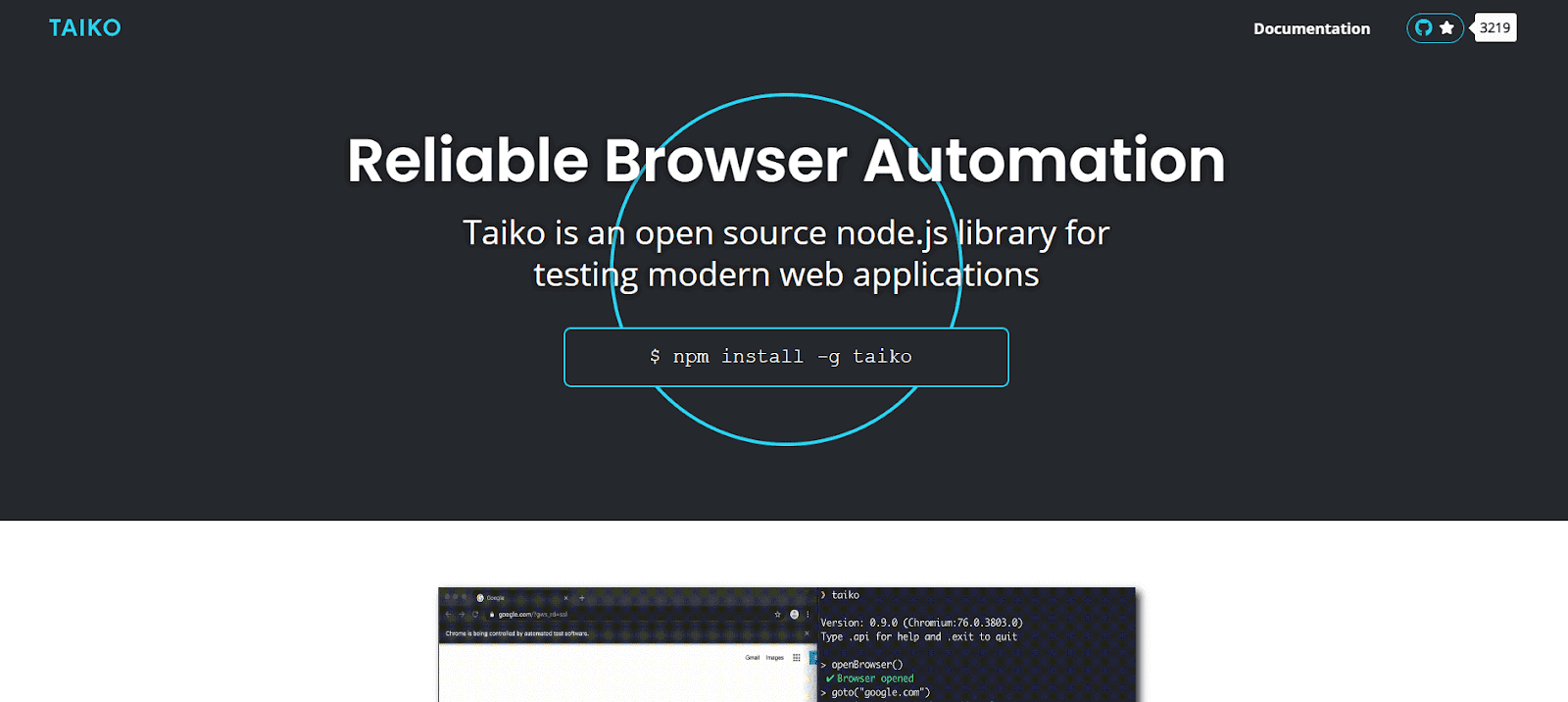
It is designed with a user-friendly API, smart selectors, and implicit waits that collectively target one ultimate objective, eliminating flaky tests.
Core features of Taiko:
Some core features that makes the Taiko one of the best test automation framework are as follows:
- The installation process of Taiko is straightforward and hassle-free, ensuring that you can quickly get it up and running without any complications.
- With the interactive recorder feature, you can easily record and capture your actions, making it a convenient tool for tracking and reproducing your interactions within the system.
- It is capable of managing XHR (XMLHttpRequest) requests and dynamic content seamlessly, ensuring that you can work with these elements effortlessly.
- You can utilize the functionality for request and response stubbing and mocking to simulate interactions, enabling thorough testing and development of your software.
23. PHPUnit
PHPUnit provides a fast platform to design and automate tests, helping you monitor your code’s behavior, detect errors, pinpoint regressions, and uphold the integrity of your code even during updates. It enables developers and testers to construct and execute unit tests for their PHP code carefully.

This approach prevents disturbance to existing functionality and makes PHPUnit an essential tool for maintaining the reliability and performance of your applications.
Core features of PHPUnit:
Some core features that makes the PHPUnit one of the best test automation framework are as follows:
- This is easier with PHPUnit because it lets developers write tests before the actual code.
- It helps generate code coverage reports, giving insights into how much code is covered by tests, making it one of the best test automation frameworks.
- Developers can create mock objects with PHPUnit, simulating the behavior of natural objects.
- PHPUnit supports data providers, enabling developers to run the same test with various data sets.
- To test their code effectively, developers can access different assertion methods provided by PHPUnit.
24. Espresso
Espresso is a mobile test automation framework for Android applications. It is developed by Google and is integrated with the Android SDK. Espresso provides a number of features that make it easy to write, run, and maintain UI tests for Android applications.
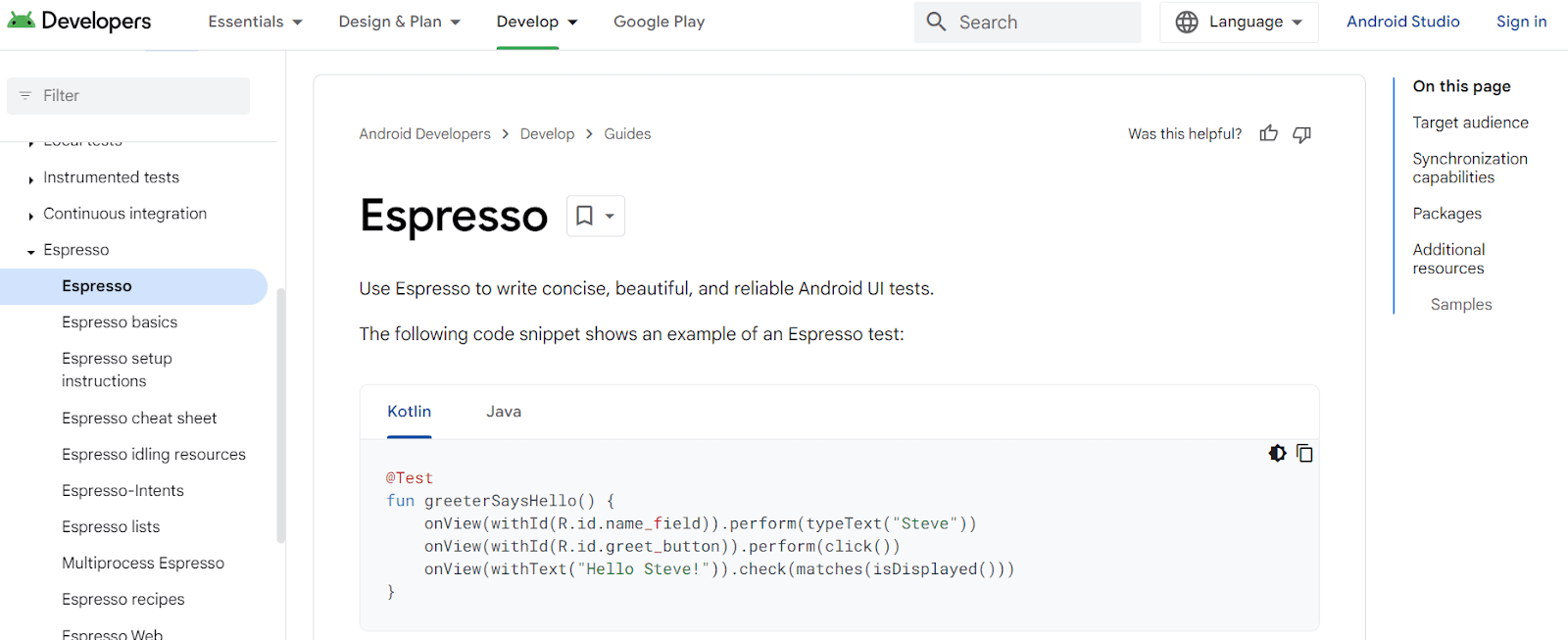
Core features of Espresso:
Some core features that makes the Espresso one of the best test automation framework are as follows:
- Espresso provides a simple and easy-to-use API for writing UI tests.
- Its tests are fast and reliable, and they can be run on various devices and operating systems.
- Espresso provides several powerful features for writing complex UI tests, such as support for data binding, custom matchers, and test hooks.
- It is integrated with the Android SDK, which makes it easy to set up and run tests.
25. XCUITest
XCUITest is a mobile test automation framework for iOS applications. It was developed by Apple and is integrated with Xcode. XCUITest provides a number of features that make it easy to write, run, and maintain UI tests for iOS applications.

Core features of XCUITest:
Some core features that makes the XCUITest one of the best test automation framework are as follows:
- XCUITest provides a simple and easy-to-use API for writing UI tests.
- Its tests are fast and reliable, and they can be run on various simulators and devices.
- It provides a number of powerful features for writing complex UI tests, such as support for gestures, custom matchers, and test hooks.
- XCUITest is integrated with Xcode, which makes it easy to set up and run tests.
26. Geb
Geb is a web test automation framework for Groovy. It is a powerful and flexible framework that can be used to test a wide variety of web applications. Geb provides a number of features that make it easy to write, run, and maintain web tests.
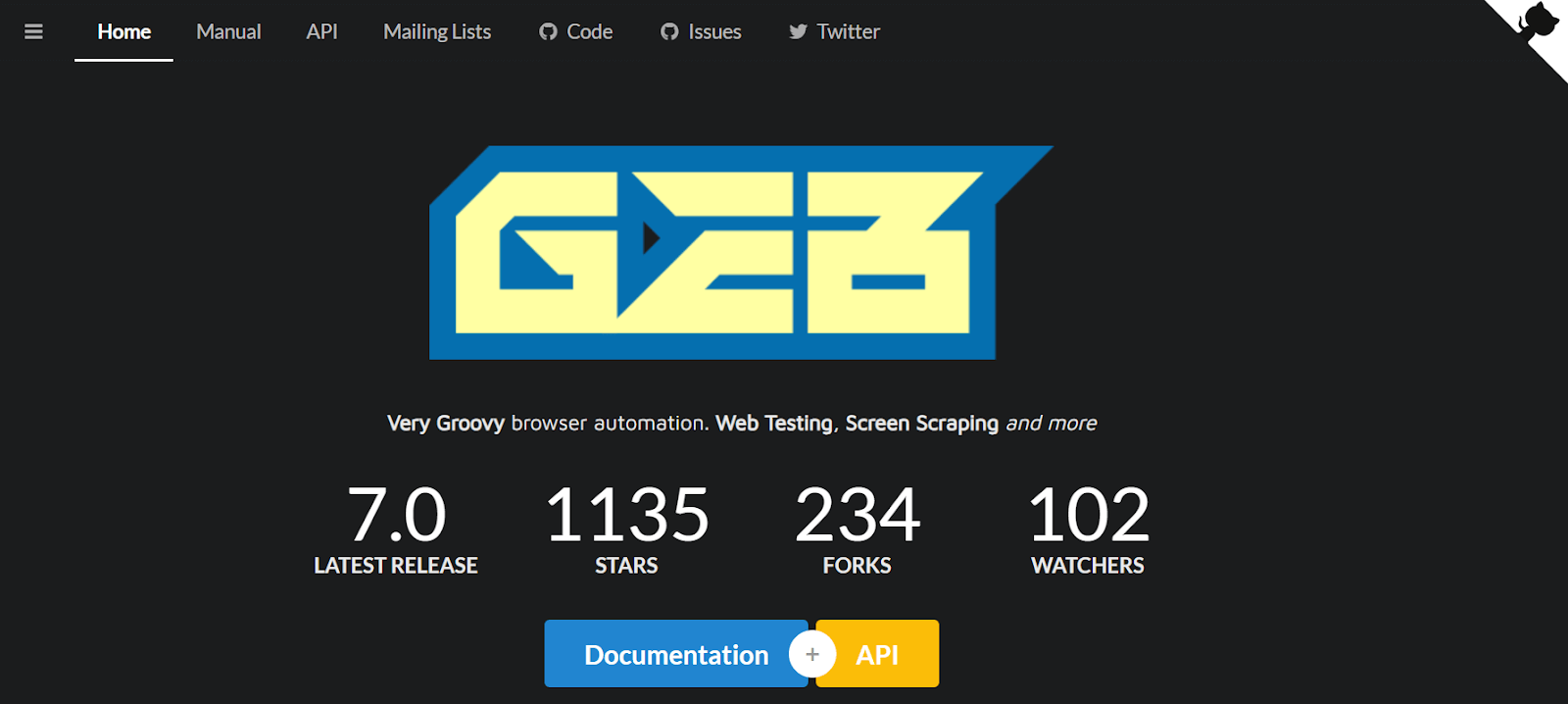
Core features of Geb:
Some core features that makes the Geb one of the best test automation framework are as follows:
- Geb provides a simple and easy-to-use API for writing web tests.
- It is a very flexible framework, and it can be used to test a wide variety of web applications, including single-page applications and applications that use JavaScript frameworks such as Angular and React.
- Geb provides a number of powerful features for writing complex web tests, such as support for page objects, data-driven testing, and custom assertions.
- It is integrated with Groovy, which makes it easy to write concise and expressive tests.
27. Laravel
Laravel testing framework is a suite of tools for writing and running automated tests for Laravel applications. It is based on the PHPUnit testing framework and provides a number of features that make it easy to write, run, and maintain tests for Laravel applications.
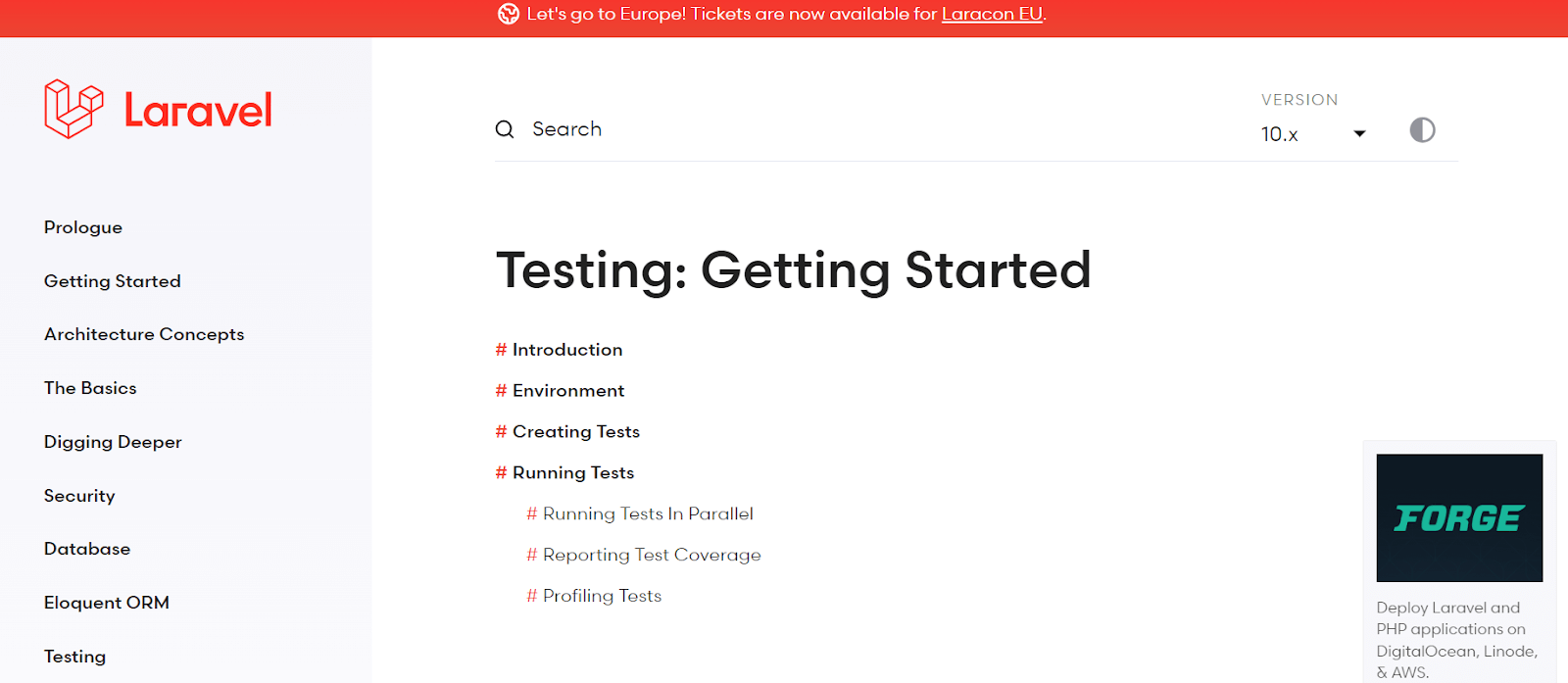
Core features of Laravel framework:
Some core features that makes the Laravel one of the best test automation framework are as follows:
- The Laravel testing framework provides a simple and easy-to-use API for writing tests.
- It can be used to test a variety of Laravel applications, including web applications, APIs, and command-line applications.
- The Laravel testing framework provides a number of powerful features for writing complex tests, such as support for database transactions, mock objects, and test factories.
- It is integrated with Laravel, which makes it easy to set up and run tests.
28. pytest-bdd
pytest-bdd is a Behavior-Driven Development (BDD) plugin for pytest, combining the simplicity and power of pytest with Gherkin feature files. It allows you to write test scenarios in plain language while leveraging all the advanced capabilities of the pytest ecosystem. Ideal for teams using Python for test automation in BDD workflows.

Core features of the pytest-bdd framework:
Some core features that makes the pytest-bdd one of the best test automation framework are as follows:
- Enables writing scenarios using Given/When/Then steps in .feature files for clear, descriptive tests.
- Seamlessly combines with pytest’s rich features like fixtures, markers, and plugins.
- Keeps the codebase clean and maintainable by aligning naturally with existing Python testing patterns.
- Allows step reuse across multiple scenarios, improving maintainability and consistency.
- Leverages pytest-xdist for executing tests in parallel to speed up test runs.
- Supports tagging, custom hooks, and parametrization for advanced test organization.
29. QUnit
QUnit is a widely used JavaScript testing framework designed for unit and integration testing, especially for frontend applications. It’s known for its simplicity, reliability, and fast execution, making it a great choice for developers working with web projects. It is actively maintained and integrates well with popular CI/CD tools for continuous testing.

Core features of QUnit:
Some core features that makes the QUnit one of the best test automation framework are as follows:
- Offers a variety of assertions to check your code’s behavior, ensuring accurate test outcomes.
- Supports testing asynchronous code, providing methods to manage timeouts and delays in test execution.
- Provides hooks like beforeEach and afterEach for setting up and tearing down tests.
- Tests can be organized into modules for better structure and readability.
- Easily integrates with popular continuous integration systems like Jenkins and Travis CI.
30. RSpec
RSpec is a Behavior Driven Development (BDD) framework for Ruby. It allows you to write your tests in plain English, making them more readable and maintainable. RSpec can be used to test a variety of applications, including web applications, command-line applications, and APIs.
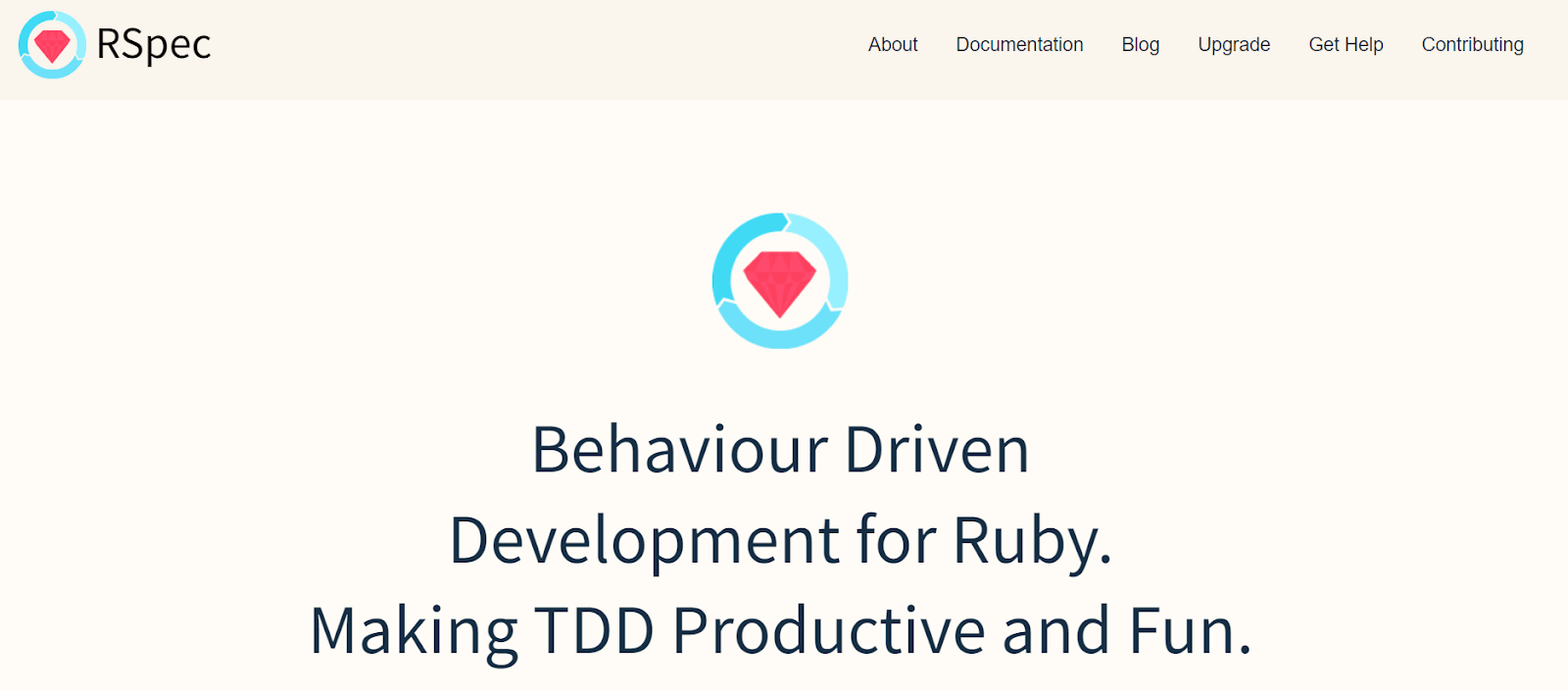
Core features of RSpec:
Some core features that makes the RSpec one of the best test automation framework are as follows:
- RSpec provides a simple and easy-to-use API for writing tests in plain English.
- It can be used to test a variety of applications, including web applications, command-line applications, and APIs.
- RSpec provides several powerful features for writing complex tests, such as support for nested examples, shared examples, and let and before blocks.
- RSpec is integrated with Ruby, which makes it easy to set up and run tests.
31. Reqnroll
Reqnroll is a modern Behavior-Driven Development (BDD) automation framework for .NET, created as a direct continuation and drop-in replacement of SpecFlow. It supports the same Gherkin syntax and C# integration, making it easy for teams to migrate without changing existing test suites or workflows. Designed for scalability and maintainability, Reqnroll keeps BDD practices alive in the .NET ecosystem.

Core features of Reqnroll:
Some core features that makes the Reqnroll one of the best test automation framework are as follows:
- Write feature files in natural language with a Given/When/Then structure for clear and collaborative testing.
- Works seamlessly with C#, supporting NUnit, MSTest, and xUnit for flexible test execution.
- Uses the same project layout and syntax as SpecFlow, simplifying upgrades and transitions.
- Compatible with Visual Studio for syntax highlighting, code navigation, and test execution.
- Works with .NET Core and integrates well into modern CI/CD pipelines.
32. MSTest
MSTest is a unit testing framework for .NET. It is integrated with Visual Studio and provides a number of features that make it easy to write, run, and maintain unit tests.

Core features of MSTest:
Some core features that makes the MSTest one of the best test automation framework are as follows:
- MSTest provides a simple and easy-to-use API for writing unit tests.
- It is integrated with Visual Studio, which makes it easy to set up and run tests.
- MSTest provides a number of powerful features for writing complex unit tests, such as support for mocking, test data, and test hooks.
33. unittest
unittest is a unit testing framework for Python. It is integrated with the Python standard library and provides a number of features that make it easy to write, run, and maintain unit tests.

Core features of unittest:
Some core features that makes the unittest one of the best test automation framework are as follows:
- Unittest provides a simple and easy-to-use API for writing unit tests.
- It is integrated with the Python standard library, which makes it easy to set up and run tests.
- Unittest provides a number of powerful features for writing complex unit tests, such as support for mocking, test data, and test fixtures.
34. Behave
Behave is a widely adopted Behavior-Driven Development (BDD) framework for Python that enables writing test scenarios in plain, descriptive language. It’s designed to improve collaboration between developers, QA engineers, and business stakeholders by using human-readable Gherkin syntax. Behave excels in bridging the communication gap between technical and non-technical team members.

Core features of Behave:
Some core features that makes the Behave one of the best test automation framework are as follows:
- Allows you to define features and scenarios in plain English, encouraging shared understanding across teams.
- Works well with libraries like requests, Selenium, pytest, and more, making it flexible for many test environments.
- Behave is regularly updated, actively maintained, and widely used in production projects.
- Supports testing for web applications, APIs, CLI tools, and microservices.
- Provides robust support for setup and teardown logic, and integrates cleanly with step definitions.
- Easily configurable for running scenarios with tags, custom formatters, and environment-specific setups.
35. Nemo.js
Nemo.js is an open-source test automation framework for Node.js. It is based on Selenium and provides a number of features that make it easy to write, run, and maintain web tests.
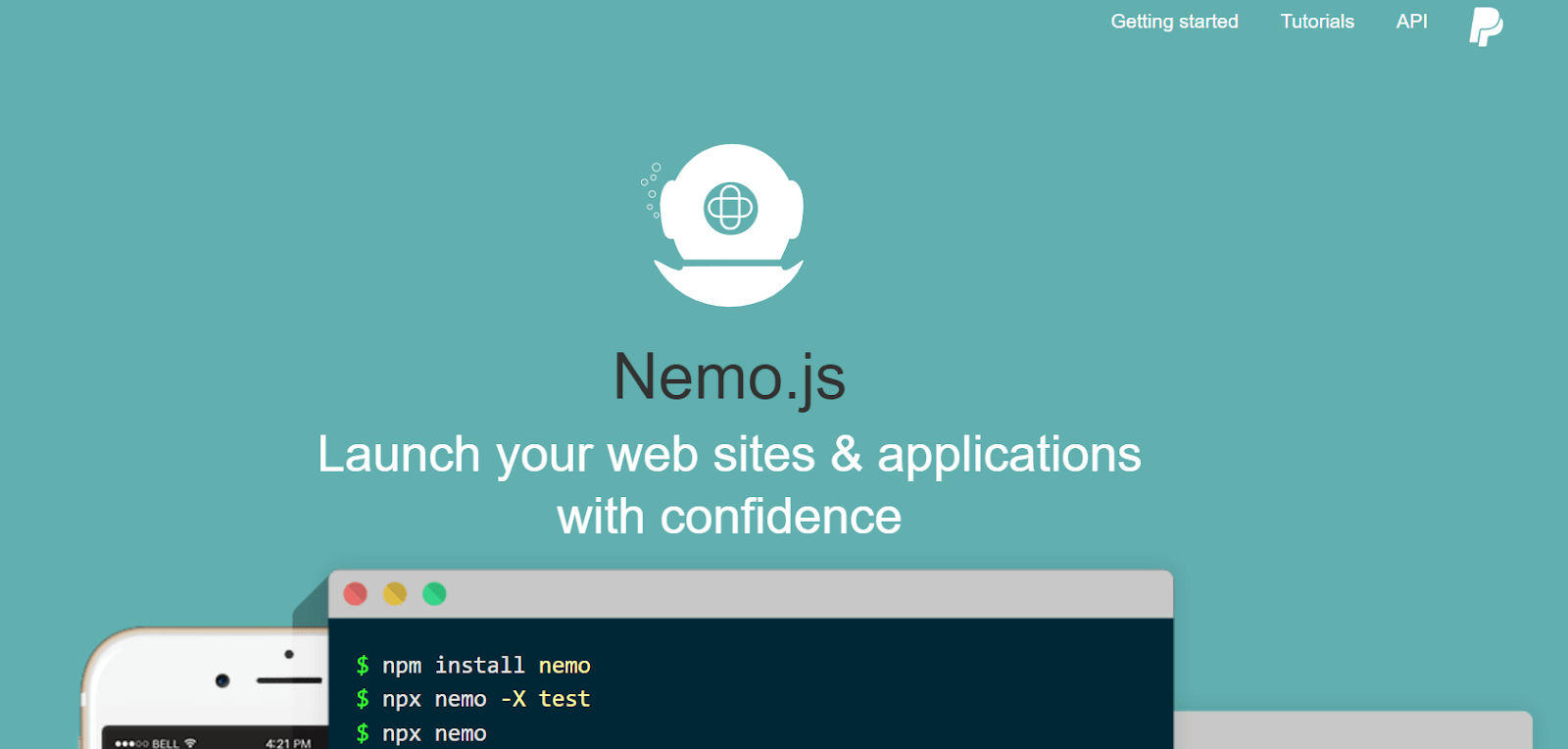
Core features of Nemo.js:
- Nemo.js provides a simple and easy-to-use API for writing web tests.
- It can be used to test various web applications, including single-page applications and applications that use JavaScript frameworks such as Angular and React.
- Nemo.js provides a number of powerful features for writing complex web tests, such as support for page objects, data-driven testing, and custom assertions.
- Nemo.js is integrated with Node.js, which makes it easy to set up and run tests.
By leveraging the above-mentioned best test automation frameworks, you can run automated tests at scale.
However, when running tests, you need to choose wisely between the local and cloud grids. Testing on a local grid can be time-consuming and expensive. It can be challenging to set up and maintain a large enough grid to test your application on a wide range of devices and browsers. Additionally, local grids can be unreliable and unable to support the demands of your testing process.
Cloud testing is a solution to the challenges of local grid testing. Cloud testing platforms provide access to a large and scalable infrastructure of devices and browsers. This allows you to test your application on a wide range of devices and browsers without having to set up and maintain your grid. Additionally, cloud testing platforms are typically more reliable than local grids and can support the demands of even the most complex testing processes.
LambdaTest is an AI-native test orchestration and execution platform that helps you run automation tests on scale across 3000+ real devices, browsers and OS combinations, This platform offers a secure, scalable, and reliable infrastructure. It supports a wide range of test automation frameworks, including Selenium, Cypress, Playwright, Appium, and more.
Here are some ways LambdaTest can help you in automation testing using different frameworks:
- It supports parallel testing, which allows you to run multiple tests simultaneously across different browsers and devices. This can help you to reduce the time it takes to execute your tests.
- LambdaTest integrates seamlessly with the best test automation frameworks, so you can start testing your application quickly and easily.
- It provides advanced debugging tools, such as video recording, network logs, and console logs, which can help you to identify and fix bugs quickly.
- LambdaTest provides a scalable mobile device lab of thousands of real Android and iOS devices.
Check the documentation to get started with test automation on LambdaTest.
Wrapping up
When it comes to test automation, the choices are abundant, and each solution boasts unique strengths and limitations. This compilation highlights the 35 best test automation frameworks However, before making your selection, it’s imperative to assess the specific requirements of your software project carefully.
Take into account the type of web or mobile application you’re testing, your team’s coding proficiency, and your language preferences. Once you’ve gained a comprehensive understanding of these factors, delve into the evaluation of the testing capabilities of the frameworks. Consider their level of community support and their compatibility with different software application versions and environments.
Frequently Asked Questions (FAQs)
What is the most popular automation test framework?
There are multiple test automation frameworks, such as Selenium, Cypress, Appium, and more. However, Selenium is a widely used framework. It optimizes code readability, improving your test efficiency and productivity, allowing you to test faster and deliver better software.
What is the framework for test automation?
Simply put, a test automation framework is a set of guidelines that helps run tests and gives detailed reports about the results. To build a successful test automation framework, you need several important parts: tools, equipment, scripts, procedures, and, most importantly, skilled test automation engineers.
How do I choose a test automation framework?
To choose a test automation framework, consider your project’s requirements, programming language preferences, and the support for testing tools and technologies you plan to use.
What makes a good test automation framework?
Nowadays, a good test automation framework is a must-have for any development team. It should provide a stable and reliable platform for highly productive software testing. In order to ensure efficiency and reliability, there are several requirements for test automation frameworks. These requirements include portability, documentation, scalability, usability, compatibility with various platforms/devices/OSes, etc.
Got Questions? Drop them on LambdaTest Community. Visit now














